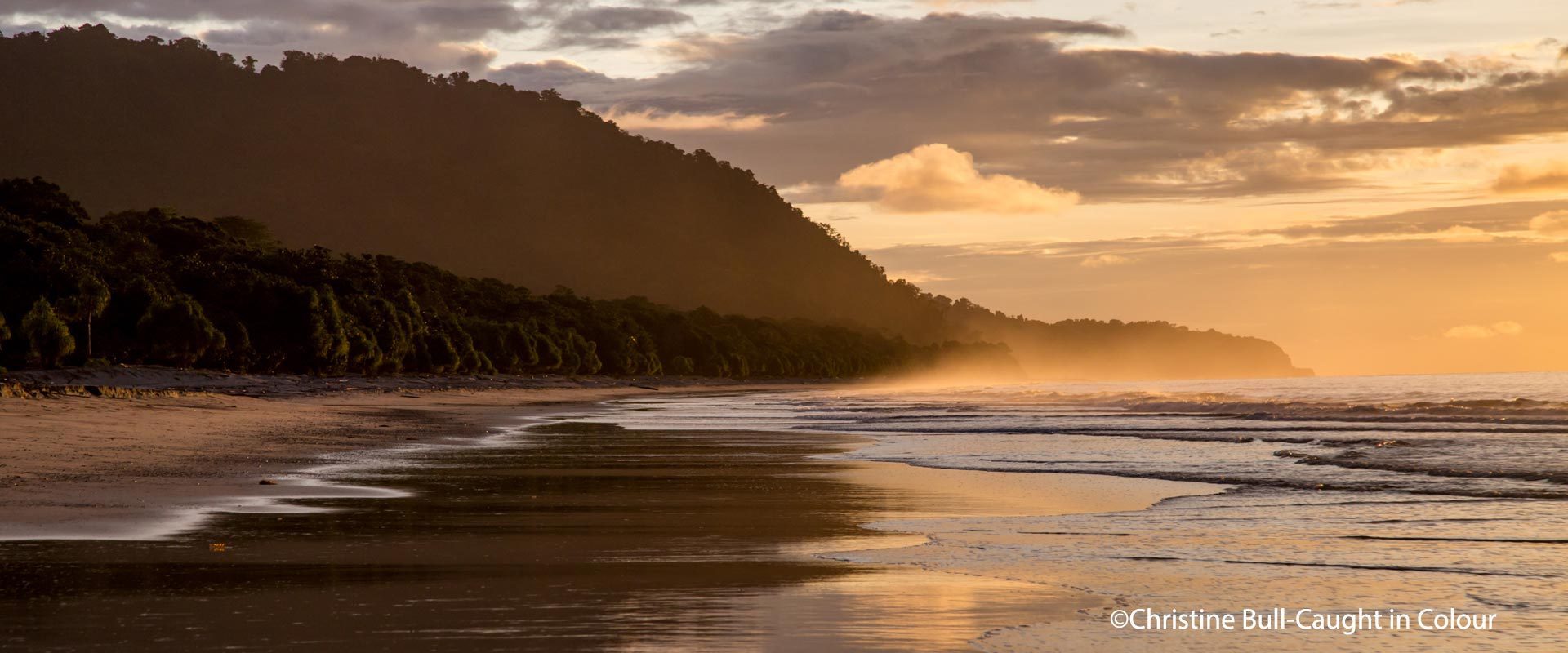Kalawai Adventure by Geoffrey Gearheart, PhD w/ images by Christine Bull
Kalawai Adventure by Geoffrey Gearheart, PhD
Images by Christine Bull
As a student Geoffrey Gearheart spent a lot of time doing research in the Bird’s Head before receiving his PhD from the Scripps Institution of Oceanography. Last year he, along with 13 fellow explorers of various nationalities, boarded the MV Putiraja for a 16 day natural history expedition through Raja Ampat and Cendrawasih Bay. Experiencing the area’s amazing terrestrial and marine wildlife was the goal of this trip.
We are excerpting Dr. Gearheart’s trip diary…(to read the entire journal and view the videos mentioned in the text click here, Kalawai Journal)…
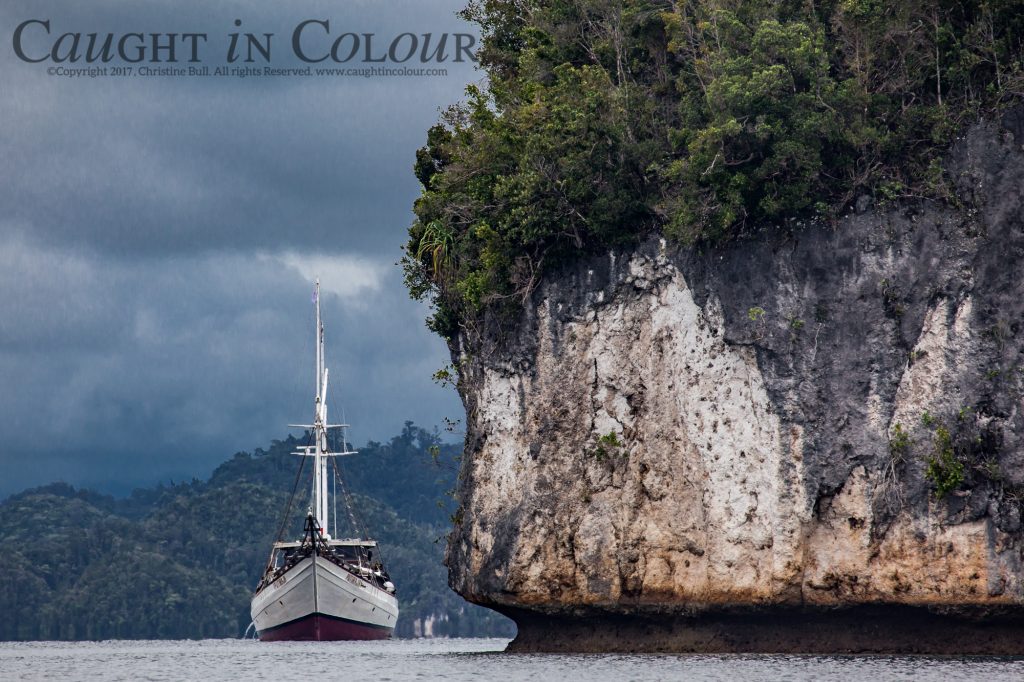
MV Putiraja dwarfed by the sheer faces of Kabui Bay, Raja Ampat
June 22: After stopping in Saporkren village in the late afternoon of June 21 to pick up Franky Mambrasar, our bird guide, we left this clean little village with it’s little church, other local institutions and a main sandy street lined with beach almonds under which people gather to share stories and sell things such as fruit and the omnipresent bundles of “sirih-pinang” (inflorescence of a Piper sp. vine and Areca/betel nuts).
Our day started at 05:00. We all got in 2 tenders to reach the bottom of the bay. It was pitch dark. We disembarked and walked inland for about five minutes, then sat down on the bank of a small river where the redbird of paradise had been seen bathing one early morning a few years ago. On the other side of the river is the immense ficus tree where Gerald Kooyman, my academic advisor at Scripps, and I had spotted a dozen BOP back in 2009. Everybody was totally silent, but the rain kept us from seeing the birds. We did hear the calls of two males and before leaving the bay we spotted a palm cockatoo (Probosciger aterrimus), which was somewhat of a consolation. We set off at around 0800 for Selpele, at the western tip of Waigeo, to report to the port officials and then headed straight on to the Island of Piai, at the edge of Raja Ampat.
June 23: We arrived at Piai in late afternoon. It is a beautiful, wild speck of land; so small yet such an important part of my life. I boarded a tender set off for the island to see who was at the post. The rest of the party joined us and I explained everything about the conservation program, the beginnings without a post, the very simple life, the challenges to get the poachers to stop killing turtles, etc. Since the inception of the program in 2006, the number of nests has increased five-fold to reach over 3,800 nests in 2016. At 20:30 we all headed back for Piai. This was a deliberate early start, as the three turtles we saw swimming in the shallows in the late afternoon suggested they’d be in a hurry to nest. The night was magical. Stars and then a moonrise revealed four huge, green turtles (Chelonia mydas) on the beach. For some of our guests this was their first encounter with a sea turtle!
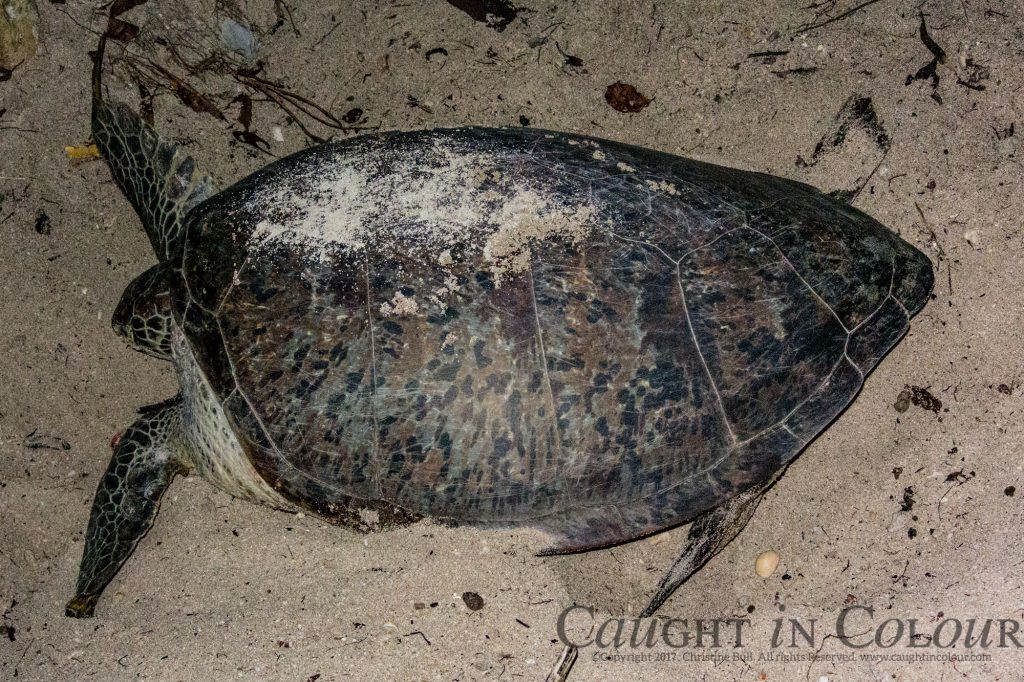
Green turtle nesting on Piai Island
June 24: We disembarked the ship for Piai at 06:30. The group was divided in three: the snorkelers, the birders and the “lazy bums” who wanted to hang out under the trees at the patrol post. I took a few guests to the western end of the main beach for a drift-snorkeling session, following the eastward current. The coral at Piai is impressive. I have seen this place improve so much over the past 11 years. There are now lots of large reef fish, turtles and sharks. My travelers were absolutely delighted. This is Raja Ampat in its full splendor. After saying goodbye to the patrols on Piai, we began steaming to Wayag at 10:00.
We reached Wayag, which never ceases to amaze me with its stunning beauty. The boat had barely cast anchor when a few of us jumped into the lagoon’s calm blue waters. We bobbed around for a while, soaking in the beauty of the landscape then set off with the rest of the group in the tenders for a snorkel at one of my favorite spots: the shoreline at the entrance of the lagoon. Here stands a large swath of incredibly delicate staghorn coral, which at low tide can be completely exposed.
After lunch, we left again on the tenders for a slow sightseeing tour, crisscrossing the maze of mushroom hills planted in the lagoon’s turquoise waters and stopping frequently to take pictures. It is difficult to describe in words the beauty of Wayag. I remembered the access point to a hidden beach on the outer side of the islands, a nesting site for green and hawksbill turtles which I’d visited several times in the past. It’s a beautiful cove graced with a steep beach of coralline sand.
June 25: At 06:30, filled with enthusiasm, a small group set off to conquer Mount Wayag, also known as Mount Pindito. The rugged path was quite impressive for it was extremely steep: an almost vertical climb but on very solid, razor sharp limestone with good footholds and lots of roots to hold on to. When we reached the top it was crystal clear the reward was worth a thousand ascents! What an incredible view! I had my drone and did two flights. I think I shot some of my best footage so far.

View from Mount Wayag
The climb down was very, very slow. During a challenging, almost vertical section one of our guests suddenly cried out: “Oh look! A bee-eater!” That’s when you know you are dealing with a die-hard birder. During the two hours of our adventure on the mountain the wind had picked up and generated a considerable swell which was now heaving the Putiraja’s stern up and down. The boat lifted anchor and met the tender at a protected spot some 20 minutes later. At around 10:00, it was decided that given the chance of more rainfall we would not attempt another stop at Aceleok Bay to see the birds of paradise, but sail straight to the Bird’s Head Peninsula.
June 26: We arrived at Batu Rumah, on the north coast of the mainland peninsula, in the early afternoon. We’d done 6-7 knots on average, against the prevailing currents. I had forgotten how incredibly wild the coastline is. There are several layers of very steep mountains, the tallest ones in the back are grey and disappear in the mist. The slender, white strips of distant waterfalls contrast against the dark green jungle. Closer to shore, giant trees with giant vines give an impression of absolute impenetrability (an illusion, as the understory of a mature rainforest is as clear and open as a Victorian park), of Nature’s dominance over everything else, especially our little ship. Suddenly, delicate creatures emerged from this other world: a pair of Blyth’s hornbills (or Papuan hornbill; Rhyticeros plicatus) flying from tree to tree.
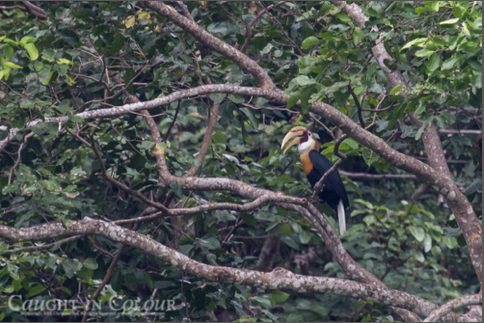
Blyth’s or Papuan Hornbill
Standing at the bow of the Putiraja, I could make out the beach at Batu Rumah, the “house rock” where I had spent many months for my fieldwork.
When the other travelers reached the shore I took them to the UNIPA post, then to the forest behind it, which is the habitat of a large population of Priam’s birdwing butterflies (Ornithoptera priamus). They are truly amazing and so numerous! The females don’t possess the males’ iridescent green color but are nonetheless beautiful and twice the size. They flutter close to the forest floor, lightly brushing the underside of leaves, and each time they deposit a minuscule pink egg. Males join in the dance and mate whenever they can. Rays of light penetrating the thick canopy are like disco strobes when they hit the birdwings’ green scales. When the eggs hatch, the caterpillars travel to a nearby Aristolochia tagala vine, their host plant. For the next 30 days they gorge themselves on Aristolochia leaves to reach an impressive size. The shiny black caterpillars measure up to 15 cm in length and have numerous orange spikes on their backs. Once mature, they metamorphose into chrysalises which in turn grow and pulsate for another 30 days before delivering the final product: a new birdwing. After watching the butterflies we walked along the beach towards Warmamedi.

Priam’s Birdwing Butterfly
It was my intention to show everybody what to expect that night, as the path can be tricky with exposed rocks to climb over at high tide. We saw at least 12 Blyth’s hornbills. The mountain face, covered in the thickest of vegetation, is almost vertical. Here and there imposing gullies of rocks and sediment have flowed down to the beach. Failures are common, especially during heavy rains and earthquakes. A high peak, visible from the camp, was cut in half during the 2007 quake, exposing dark red bedrock.
The beach of Pasir Pendek, which used to be a crescent-shaped bay back in 2012, has been completely replenished with sand and is indistinguishable from its neighbor, Warmamedi. There are lots of turtle tracks, of hawksbills (Eretmochelys imbricata), greens, olive ridleys (Lepidochelys olivacea) and leatherbacks (Dermochelys coriacea). The latter are so large they look as if tractors were driven straight out of the ocean (pictured). At Pasir Pendek we came across a nesting green turtle. We didn’t stay long with her and continued to Warmamedi. Every night the UNIPA boys patrol the entire length of the beach (22 kilometers). They agreed to signal us the presence of turtles by flashing their headlamps.
The wait began…
After a while, some of us got a little cold and impatient so we started walking to warm up our limbs. I couldn’t help but think of the possibility of not seeing turtles, and of how disappointing that would be for everyone. It was already past 01:00 when we saw flashes at the other end of the beach: the signal we’d been waiting for! We walked back swiftly for about 25 minutes when I stumbled upon the first leatherback track. It was humongous!
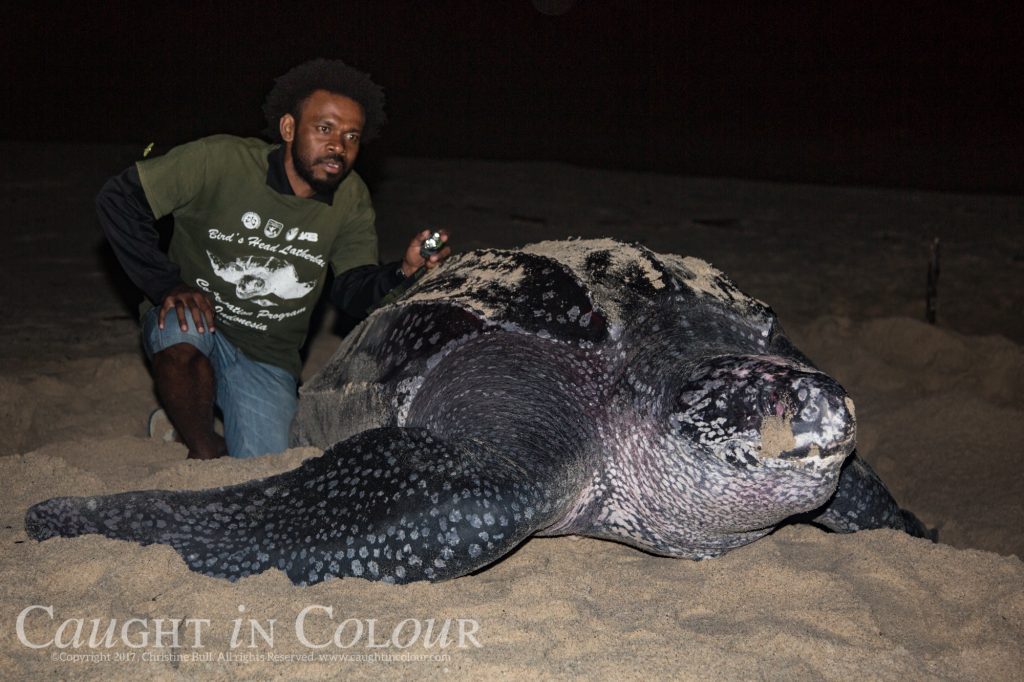
Nesting Leatherback Turtle
The turtle had just emerged and was resting at the crest of the beach. This is a delicate stage in the nesting process because the animal is still scouting the area and is very alert to danger. Any sudden movement could scare her back to sea. I warned the others who were coming behind me to turn off their red lights and walk down to the waterline. We were all gob-smacked by the sheer size of the turtle. We all waited and marveled until the leatherback was finished nesting.
Elated (and me relieved!) we returned to the Putiraja.I felt my mission was accomplished. Some of the travelers said seeing the leatherback was their highlight.
June 27: We started (again) very early this morning, at around 05:30. I had slept only 3 hours and was up again to go ashore for a forest walk. The goal was to see the lesser bird-of-paradise (Paradisaea minor). Yan Yessa was at the camp and took us on the path that starts behind the old WWF kitchen. Because the area is in disuse he had to chop his way through rattan vines –the nastiest spines I can think of- with a very sharp machete. We had our best cameras with long lenses and our hopes were high. The forest comes to life just before dawn and is filled with the most exotic animal sounds: hornbills that swoosh overhead, barking deer sounding the alarm and, of course, the complete registry of calls of the male bird of paradise. It’s the day shift on the Bird’s Head Peninsula. We saw a scrub wallaby (or pademelon; Thylogale sp.) and a herd of red muntjac (or barking deer; Muntiacus muntjak) before reaching the bird of paradise display trees.
Bird calls could be heard all around and we caught fleeting glimpses of the birds of paradise flying swiftly from one branch to the other, never staying longer than 10 seconds in place. A very difficult photographic endeavor, for by the time you’ve located the bird in the viewfinder it’s already gone! We kept trying but the birds were, despite their proximity, painfully out of reach. We continued on our walk until we reached the river. It was slow going as we had to climb up and down embankments. We managed to shoot a beautiful western crowned pigeon (Goura cristata; pictured).
At every new meander of the river we surprised wildlife. A herd of barking deer kept running away from us; the alarm-sounder giving a single loud bark prompting everyone to flee in a great stampede to the safety of the next meander where we would meet again a few minutes later. We made it back to the ship at around 10:00 for a rest, and a 17:00 we were readying ourselves for another night with the leatherbacks.
The UNIPA guys set up an open air cinema. Ken’s little projector, hooked up to a small laptop powered by UNIPA’s stinky and noisy generator, was used to show documentaries on conservation in Raja Ampat (featuring Mark Erdmann and Andy Miners from Misool Eco Resort) and about birds-of-paradise. Everybody was sitting on makeshift benches and a large tarp under the trees. The screen, a white bed sheet from the Putiraja, was attached to the wooden façade of the post. After the film, at around 22:00, several of us set off for Warmamedi. We met our first leatherback at Pasir Pendek.
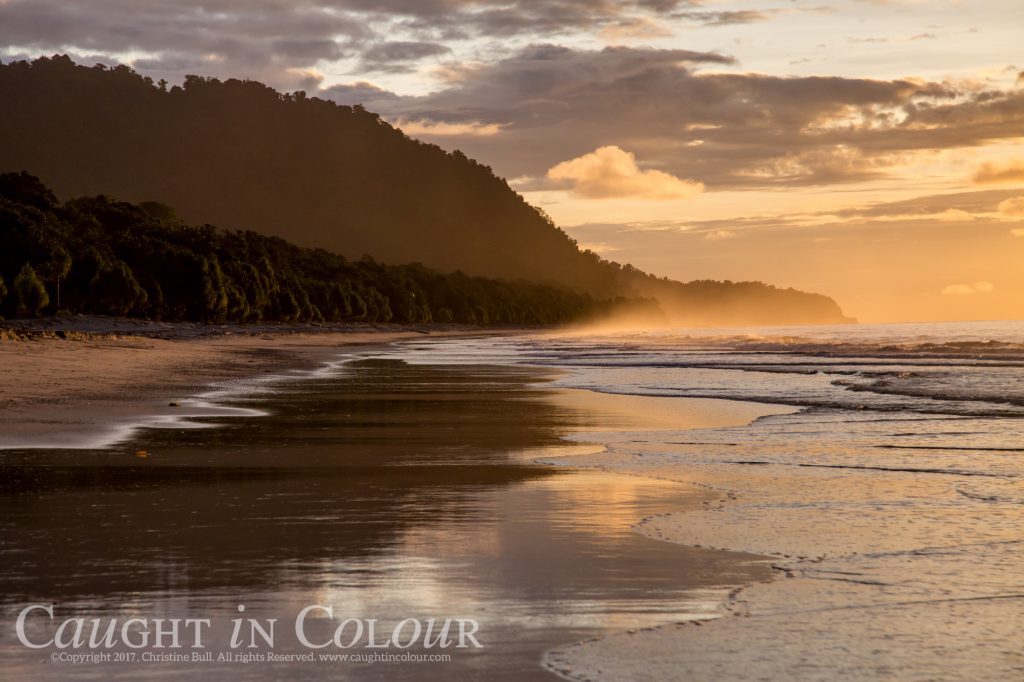
Golden Jamursba Medi Beach at sunrise
The trees in the background were lit up by thousands of pulsating fireflies in an apparent Christmas rehearsal. It is a very difficult scene to describe with words, nature is too dense and powerful and only your eyes and your senses can generate the most accurate and honest feelings. The goal of the night was to get pictures of the egg-laying process. Two more turtles came up but didn’t nest. One guests got a few more shots of the turtles returning to the water before we decided to call it a night. It was very dark and we walked back slowly. When I woke up, we were already far from Batu Rumah.
June 30: (After transiting through Manokwari to buy supplies) we finally anchored at 13:00 in Kwaitisore Bay in the southern part of Cenderawsih Bay, where whale sharks gather under floating fishing platforms called bagans. At that time of day it is steaming hot under the tarp that covers the Putriraja’s front deck. Just out of view there’s the village of Kwatisore. There are bagans here and there but I was told that because of Lebaran (Muslim holiday marking the end of Ramadan), most fishermen have gone home to Makassar. Will this impact our chances of seeing whale sharks?
We all boarded the two tenders. Our driver Yoris took us to the closest bagan. I was the first one in the water and pretty anxious. The water here is of a beautiful cerulean blue, and long, white, dancing rays of light dart towards the bottom. We all swam around the bagan several times, but there were no sharks around. I know that in the business of finding wildlife patience and optimism are the best weapons.
We didn’t have to wait long as within the hour five sharks had been spotted at another bagan.

Snorkeling with Whale shark
What a sight! Before our tenders had come to a halt we could see the dorsal fins of several sharks. The sea was boiling around the offal thrown in the water by the fishermen. I couldn’t jump in fast enough and almost landed on top of a whale shark! Looking down on them from very close they seem like slow-moving trains. I estimate their length at five to six meters. Some of the sharks carry satellite transmitters bolted onto their dorsal fins, which are used by Conservation International to track their movements so that we can learn more about the sharks’ lifecycles. Other sharks show obvious propeller injuries. These sharks, which are for the most part juvenile males, reliably return to the same area (but to different bagans), and researchers are confident they will encounter the tags, which by then are covered in barnacles and other marine life, to detach them from the sharks (the tags can then be sent back to the manufacturer to be refurbished). Almost everybody jumped in the water and I could hear the screams of delight echoing through my friends’ snorkels. Normal protocol stipulates humans should not get any closer than three meters from whale sharks. But in Cendrawasih Bay the rule is hard to follow as it isn’t the diver who goes to the shark but the other way round! While I was filming a shark from the indicated distance I suddenly felt a strong jolt, a push against the small of my back. Turning around all I could see was the open mouth of a shark that was trying to get to the food but found me on his way. It was a real pleasure to see everyone so delighted. Gone was the boredom of the long uneventful transit down the bay.
That night a few of us went back to the bagan. It was a magical experience. Bagans are clever light traps. I had seen them many times in the past without understanding how they really work. They consist of a square grid of about 25×25 meters made with strong bamboo poles that’s mounted on a single wooden ship. Thick ropes connect the four corners to heavy anchors, which keep the bagan level and stable. It is, therefore, a semi-permanent contraption, moved around seasonally on select days when seas are at their calmest. In the middle of the grid above the hull, there is a small platform on which sits a well-built wooden hut. Inside it’s tidy and painted white, and there is a mat on the floor on which the five fishermen gather to eat, drink tea, sleep and watch Indonesian thrillers on a large-screen TV. For those with a delicate back, fishnets are hung between the bamboo beams outside. There is also a powerful sound system and everywhere there are lights. A complicated switchboard connected to a large diesel generator suggests electricity is a key component of a bagan.
The fishermen are young and friendly and very happy to have us around. Putiraja’s owners made a deal with them: they should feed the whale sharks around the clock to ensure they stick around for the length of our stay. I can imagine the recurrent question researchers, who take advantage of this unique opportunity to study them, face when presenting their findings to their peers: “the behavior you describe is not representative of a wild animal”. It’s an argument that’s difficult to counter. Yet, Cendrawasih Bay offers unparalleled access to these largest of fish, so any new insight on migratory behavior is better than no insight and it is also a test bed for new tracking techniques.
The bagan’s bamboo frame is lined with light bulbs spaced one meter from each other. When at the beginning of the night all lights are on, the Bay seems littered with bright stars floating on the surface of its black waters. Fish are attracted from far away and converge to the treacherous bagans. When enough fish have gathered, the chief fisherman turns off the outer line of lights. The fish aggregate a little closer and are now underneath the bamboo structure, which is now lit from a smaller square area all the way to the center (pictured). This stage lasts another hour. The final act consists in leaving on one single very bright light underneath the central platform.
The bulb hangs close to the waterline and is contained within a tunnel of thick carpet that hangs like a curtain, its lower end touching the water. No light escapes through the sides, there’s only a single powerful beam that shines straight down. A thick, whirling cloud of confused fish congregates around the apparent safety of the central beam: it’s time for the kill. The fishermen swiftly pull up the lift-net that’s hanging underneath the unsuspecting catch, tying it up in sections to the frame with a clever knot.
Working their way from the outer edges to the center, they concentrate the fish into a single pocket of the net. I counted five to six different species of silver fish, which were scooped up with dip nets and sorted by type into iceboxes. Everything goes fast and the most remarkable thing is that the whale sharks only show up at this final stage. They have learned over the years that this is when they get the leftovers: anchovies and a few other species that don’t sell at the fish market of Nabire are tossed straight into their eager mouths. Since tourists started coming to the bay less than 10 years ago, this relationship has become mutually beneficial as fishermen earn additional income from visiting ships. It is a strong illustration of the virtues of tourism when well managed. The boys on the bagan are truly fond of the sharks, and vice versa.
July 1: This morning one of our group came back from her early morning birding trip with a huge smile on her face. She saw birds-of-paradise! Later we all went back to the bagan. The fishermen had caught a whale shark overnight. I am not sure if it was by accident or a perk to please us. I hope the former. The animal was lying motionless on its belly in a pocket of the net and was breathing slowly. The fisherman explained it had been eating fish until the wee hours and, completely satiated, fell asleep. I believed him as when I swam to have a close look at the animal it seemed totally relaxed. Later, when they were untying the knots off the frame of the bagan and the net was loosening up around the fish, it started moving to and fro, slowly at first but then when it felt the net wasn’t holding it back anymore it became more agitated. Once its head was clear it swam out with a few powerful strokes of its tail.
In the afternoon a few of us scuba dived with the whale sharks. Because the water wasn’t very clear, I enjoyed the snorkeling more. I shot some more drone videos, of the PR surrounded by whale sharks, but it was difficult to get them all in the same frame. Later in the evening, after the table on the front deck was cleared, I gave my last presentation, on leatherback hatchling dispersal, my PhD work at Scripps.
July 2: We left at 06:00 for the bird of paradise site, deep into the mangroves. The landing spot is beautiful, the sea calm as a lake and there is coral all around. We went through a natural tunnel among the mangrove and left the boats. The first part of the walk is on planks balanced on logs, to avoid walking in the muddy water. The end of the path is at the foot of a hill. It was getting darker as a rainstorm was approaching. We hoped it’d spare us in order to break the “Paradise Curse” which has pursued us on this trip. The hike was in a beautiful jungle and easy as long as the ground was dry. Everyone followed behind. When we reached the lookout we could hear the lesser birds of paradise and got a glimpse of a fluffy tail up in the display tree. But right then it started to pour, and really pour. Our guides ushered us to a rain shelter under which we all huddled for the next 30 minutes, until the palms on the roof were so thoroughly saturated water started cascading through. It was time to leave as some of us were falling because the ground was turning into slippery mud. We left the shelter a little bummed out and headed back up the hill.
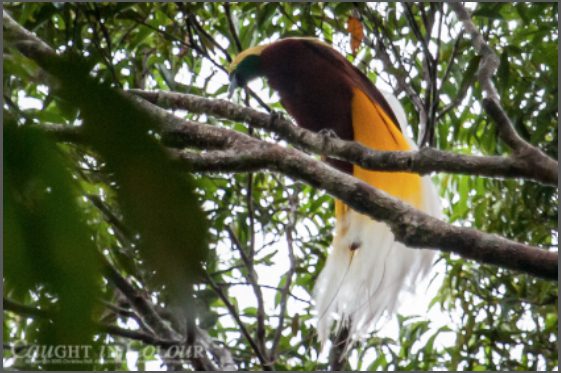
Lesser Bird of Paradise
A few moments later, as we were standing in view of the display tree, the rain stopped. Above us, we heard the cacophony of the male birds of paradise who were heading back for their morning dance. I had to make a decision as the group was now divided and I couldn’t expect the non-birders to be patient for something they obviously were not thrilled about anymore. I asked the tender driver to take the non-birders back to the boats and promised them we’d be joining them shortly. A mere instant after they left, four birds of paradise started dancing, vibrating their puffed-up yellow and white tail feathers. Females joined the fray jumping swiftly from one branch to the other to inspect and evaluate each of the males. Every time that happened I would have wonderful views of the entire birds, with their metallic green throats and dark red chests. But they never stayed longer than 10 seconds on one spot. It was evident that in the bird of paradise world this daily ceremony is a big deal and requires 100% focus and commitment. After about an hour, we returned to the boat landing, boarded and the Putiraja lifted anchor and started its long voyage north towards Manokwari and then Sorong.
Geoffrey Gearheart PhD, originally from Holland, holds advanced degrees in marine biology, tropical biology, and oceanography. His work takes him around the world. To know more about him and his work, visit his website, Geoffrey Gearheart.
Australian, Christine Bull, travels the world in pursuit of images. You can learn more about her and her photography by visiting her website, Caught in Colour.





































